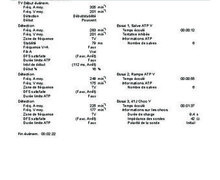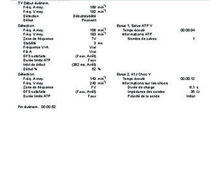Antitachycardia pacing in the VF zone
Tracing
Manufacturer Abbott
Device ICD
Field Securesence
N° 2
Patient
This 57-year-old man received a Abbott Ellipse™ VR ICD for the management of hypertrophic cardiomyopathy complicated by episodes of symptomatic sustained VT. Multiple episodes of VT recorded in the device memory were observed during a routine visit.

Graph and trace
Tracing 2A
- probable sinus tachycardia; cycles classified VS;
- sudden acceleration of the tachycardia with cycles classified in the VF zone; fast and regular tachycardia, with change in morphology of the ventricular EGM (criterion in favor of a ventricular origin): probable fast VT detected in the VF zone;
- the VF counter is full (12);
- ATP during the charge; onset of charge during a sequence of ATP (burst of 8 complexes);
- relatively short charge (a previous, incomplete charge without shock delivery is visible in the beginning of the tracing) though the shock could not be delivered in absence of a fast cycle; the burst was successful and restored sinus rhythm; after 3 consecutive VS-classified cycles, return to sinus rhythm was diagnosed;
Tracing 2B
- probable sinus tachycardia;
- probable fast VT detected in the VF zone;
- the VF counter is full (12);
- ATP during the charge; onset of charge during a sequence of ATP (burst of 8 complexes);
- the burst was successful and restored sinus rhythm; after 3 consecutive cycles classified VS, return to sinus rhythm was diagnosed and the charge was aborted;
Tracing 2C
The patient was seen again and the device was reprogrammed (ATP preceding the charge in the VF zone)
- probable sinus tachycardia;
- probable fast VT detected in the VF zone;
- the VF counter is full (20);
- ATP preceding the charge; sequence of ATP (burst of 8 complexes) without charge of the capacitors;
- unsuccessful burst; the arrhythmia continues;
- after 6 F classified cycles, VF is redetected and the capacitors begin to charge;
- persistence of tachyarrhythmia; at the end of the charge, a 30-J shock is delivered on the second (short) cycle following the end of charge;
- successful shock;
Other articles that may be of interest to you

EGM recordings






One of the main objectives when programming an ICD is to minimize to a maximum the number of shocks while preserving the patient’s safety. A considerable proportion of fast tachycardias diagnosed in the VF zone is organized and monomorphous and can be terminated by ATP. However, in the past, doubts regarding the efficacy of ATP and fear of accelerating the arrhythmia and threatening the patient’s prognosis have limited its use for the treatment of very fast tachycardias. While the efficacy of electric shocks in the termination of fast ventricular arrhythmias is unquestionable, they are painful and increase considerably the energy consumption. The delivery of several consecutive shocks is a cause of premature depletion of the batteries and of noticeable lowering of the quality of life. Several cases have been reported of depression or anxiety caused by the delivery of a series of shocks. Furthermore, the adverse effects of electric shocks have been clearly shown, including a significant shortening of survival with the number of shocks delivered. Several studies have found that the use of ATP sequences in the VF zone a) is effective and painless, b) limits the consumption of the batteries, and c) considerably improves quality of life, thus should be used as a first therapy, including in the VF zone. It is a class I indication in the updated professional guidelines. In this patient, the considerably fewer shocks delivered compared with the programming of shocks exclusively in the VF zone represents a clear advantage. The newer defibrillators made by St. Jude Medical enable the programming of ATP during or before the charge.
When ATP is programmed during the charge, the diagnosis of VF triggers simultaneously the charge of the capacitors and the sequence of ATP. The characteristics of ATP during the charge are the same as those of the first ATP sequence of the fastest VT zone. The shock is not delivered if the sequence is successful. The clear advantage is the termination of the tachycardia without shock delivery, a key factor in the preservation of quality of life and prognosis of the patient. On the other hand, the charge of the capacitor consumes energy, which may be problematic if the episodes are repetitive. A charge to the highest level consumes, depending on the manufacturer, energy corresponding to 10 to 20 days of normal battery consumption.
ATP preceding the charge may lower the consumption of energy. Once the diagnosis of VF made, ATP is delivered. When VF is reconfirmed after the delivery of ATP, the charge of the capacitor begins. If the arrhythmia is terminated, the charge is not initiated. Thus, successful ATP spares the charge of the capacitors. Conversely, unsuccessful ATP delays the shock delivery by a few seconds.